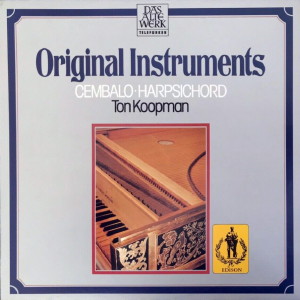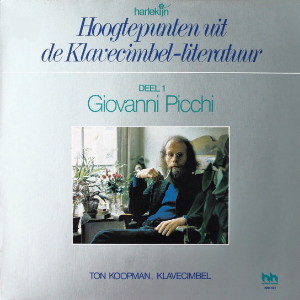 |
1 LP -
Telefunken 6.42212 AP (p) 1976
|
 |
| 1 LP -
Harlekijn 2925 522 (p) 1976 |
|
| ORIGINALINSTRUMENTE - Cembalo |
|
|
|
|
|
|
|
| Giovanni Picchi
(um 1575 - nach 1630) |
Toccata
(FWV. book I 174)
|
|
4' 45" |
A1 |
|
Ballo
detto il Picchi |
|
2' 02" |
A2 |
|
Ballo
Ongaro |
|
2' 30" |
A3 |
|
Padoana
ditta la Ongara |
|
3' 50" |
A4 |
|
Pass'e
mezzo, antico di sei parti |
|
5' 40" |
B1 |
|
Saltarello
del ditto Pass'e mezzo |
|
1' 15" |
B2 |
|
Todesca |
|
1' 45" |
B3 |
|
Ballo
ditto il Stefanin |
|
1' 55" |
B4 |
|
Ballo
alla Polacha |
|
3' 05" |
B5 |
|
|
|
|
|
| Ton KOOPMAN,
Cembalo (erbaut von Willem
Kroesbergen nach einem
italienischen Instrument von
Stephanini) |
|
|
|
|
|
Luogo
e data di registrazione |
|
Prinsenhof,
Delft (Olanda) - 1976
|
|
|
Registrazione:
live / studio |
|
studio |
|
|
Producer |
|
Adriaan
Verstijnen
|
|
|
Recording
Supervision
|
|
Wim
Verschoor |
|
|
Edizione LP |
|
TELEFUNKEN
- 6.42212 AP - (1 LP - durata 26'
47") - (p) 1976 - Analogico |
|
|
Originale LP
|
|
HARLEKIJN
- 2925 522 - (1 LP - durata 26'
47") - (p) 1976 - Analogico |
|
|
Prima Edizione CD |
|
-
|
|
|
Note |
|
Produced
by Harlekijn, Holland
|
|
|
|
|
The
harpsichord is
probably of
Italian origin and
there is
documentary
evidence of it
going back to the
14th century; the
oldest instrument
that has been
preserved was
built in 1521 in
Rome. Up to the
middle of the 17th
century Italy held
a leading place in
harpsichord
construction, and
it was not until
the activities of
the Ruckers family
in Antwerp that
the point of
emphasis shifted
to the north. The
instrument played
in this recording
is a copy of the
harpsichord in the
Frankfurt Museum
constructed by
Stephanini, the
details of whose
life and
circumstances are
obscure; the copy
itself is located
in the Prinsenhof
at Delft. The
instrument
features all the
characteristics of
Italian
harpsichord
construction in
its 17th century
heyday. It has two
manuals and two
choirs, as well as
two 8 and one 4
stops, indicating
a clear preference
for the upper
voices. From the
literature
point of
view
interpretation is
restricted on such
instruments, but
graduated
expression can be
achieved by way of
the stops. The
instrument played
here provides
within a
restricted
framework the
possibility of
influencing tonal
quality by touch.
The classical
Italian
disposition of
that time, as
provided with the
instrument played
here, despite the
clarity in all
tonal ranges of
the pieces
recorded here, is
unable to
emphasise
individual voices
in polyphonic
music with
simultaneous clear
tracing of the
others. (A
two-manual
harpsichord in
Bachs day
contained as a
rule one 4, two
8 and one 16
registers, as well
as a lute stop).
In the 17th
century, however,
there was a
particularly
intensive
alternating
relationship
between instrument
building,
composition and
performance
techniques. It was
also part of the
mentality of
Italian music of
that time that it
preferred melodic
styles of
composition.The
organ music of
Frescobaldi for
instance, the
famous
contemporary of
Picchi, as opposed
to German organ
music of the 17th
century, placed
little importance
upon development
of the pedal, but
was virtuoso in
the treatment of
the upper voices
(the Italian
organs in their
disposition were
more oriented
towards
development of the
upper voices than
towards the
pedal).
In these recorded
compositions of
Giovanni Picchi
(born 1575, died
probably soon
after 1630) the
attitude towards
the instrument at
the height of
contemporary
development is
clearly expressed.
From the point of
view of
development
history, his balli
are among the most
important
collections of
Italian dances for
keyboard
instruments. They
are, with one
exception, in two
parts; the ballo
in even time is
followed by a
second part in
uneven time. The
virtuoso developed
performance
technique
incorporates
ornamentation
which is more than
mere
embellishment; it
is an essential,
integral part of
the composition.
Another noteworthy
point is the
differentiation of
national dance
characters. How
important Picchi
must have been in
his day is evident
from the fact that
one of his
toccatas was
included in the
Fitzwilliam
Virginal Book, the
most significant
collection of
English virginal
music.
Ton Koopman has
examined in detail
the various styles
of harpsichord
playing and
construction;
prizes and awards
in competitions
founded and
furthered his
international
reputation as a
harpsichord player
and expert on
early music.
Ton
Koopman
(English
translation by
Frederick A.
Bishop)
|
|
|

